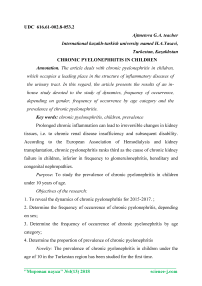Chronic pyelonephritis in children
Автор: Ajtmetova G.A.
Журнал: Мировая наука @science-j
Рубрика: Естественные и технические науки
Статья в выпуске: 4 (13), 2018 года.
Бесплатный доступ
The article deals with chronic pyelonephritis in children, which occupies a leading place in the structure of inflammatory diseases of the urinary tract. In this regard, the article presents the results of an in-house study devoted to the study of dynamics, frequency of occurrence, depending on gender, frequency of occurrence by age category and the prevalence of chronic pyelonephritis.
Chronic pyelonephritis, children, prevalence
Короткий адрес: https://sciup.org/140263473
IDR: 140263473
Текст научной статьи Chronic pyelonephritis in children
Prolonged chronic inflammation can lead to irreversible changes in kidney tissues, i.e. to chronic renal disease insufficiency and subsequent disability. According to the European Association of Hemodialysis and kidney transplantation, chronic pyelonephritis ranks third as the cause of chronic kidney failure in children, inferior in frequency to glomerulonephritis, hereditary and congenital nephropathies.
Purpose : To study the prevalence of chronic pyelonephritis in children under 10 years of age.
Objectives of the research:
-
1. To reveal the dynamics of chronic pyelonephritis for 2015-2017. ;
-
2. Determine the frequency of occurrence of chronic pyelonephritis, depending on sex;
-
3. Determine the frequency of occurrence of chronic pyelonephritis by age category;
-
4. Determine the proportion of prevalence of chronic pyelonephritis
Novelty: The prevalence of chronic pyelonephritis in children under the age of 10 in the Turkestan region has been studied for the first time.
Introduction . In the structure of inflammatory diseases of urinary tracts the leading place is occupied by pyelonephritis. Chronic pyelonephritis, according to generalized data, is the most frequent kidney disease. In modern classification of diseases (ICD 10) chronic pyelonephritis is considered in the section of chronic tubulointerstitial nephritis. Such an association is based on the commonality of morphological changes with the primary lesion of the tubules and interstitium.
Pyelonephritis is a nonspecific microbial-inflammatory disease of the calyx-tubular system and tubulointerstitial tissue of the kidneys with predominant lesion tubulointerstitium. Chronic pyelonephritis - renal damage, manifested by cicatricial changes (fibrosis) and CHL deformity, as a result of repeated IMS, usually in the background of anatomical abnormalities urinary tract or obstruction, which are confirmed by visualizing diagnostic methods.
Results of own research
The design of the study is a retrospective and method research - statistical (Excel). In the Turkestan region, the dynamics of chronic pyelonephritis in children is growing every year. According to statistics for 2015 in Turkestan city polyclinic appealed 67 sick children, 45 of them girls, and in 2016 82 sick children, 55 of them girls and in 2017 96 sick children, 65 of them girls. Frequency the incidence of chronic pyelonephritis in girls exceeds 2 times than in boys.
Pyelonephritis in most cases is caused by one uropathogen, but with frequent relapses and against the background of developmental malformations, microbial associations up to 62% of cases. Currently, among pathogens in children, Gram-negative flora also predominates, with about 90% attributable to infection with Escherichia coli bacteria. Among the other pathogens, the prevalence of IMS is Proteus mirabilis, Klebsiella spp.
For 2015 with chronic obstructive pyelonephritis - 30 children, nonobstructive chronic pyelonephritis - 12 children, unspecified chronic tubulointerstitial nephritis – 8 children and other chronic tubulointerstitial nephritis - 17 children.
For 2016 with chronic obstructive pyelonephritis - 29 children, nonobstructive chronic pyelonephritis -10 children, unspecified chronic tubulointerstitial nephritis – 4 children and other chronic tubulointerstitial nephritis - 39 children.
For 2017 with chronic obstructive pyelonephritis - 37 children, nonobstructive chronic pyelonephritis - 6 children, unspecified chronic tubulointerstitial nephritis - 10 children and other chronic tubulointerstitial nephritis – 43 children.
In 2015, 67 sick children, and in 2016 82 and for 2017, 96 sick children. The disease tends to increase. The increase in morbidity in girls is higher than in boys.
In children of primary school age (7-10 years) the frequency of occurrence is higher. Among the forms of chronic pyelonephritis, there is an increase in the proportion of other chronic tubulointerstitial nephritis.
High figures of its prevalence, the tendency to increase the number of sick children with chronic pyelonephritis dictate the need for close attention to this problem.
Список литературы Chronic pyelonephritis in children
- Rudichenko E. V. Disturbances in lipid metabolism and peroxidation system in patients with chronic pyelonephritis / EV Rudichenko // Clinical medicine. - 2006. - Т. 84. - № 5. - P. 54-58.
- Thomas B. Newman. The New American Academy of Pediatrics Urinary Tract Infection Guideline // Pediatrics. - 2011. - Vol. 128. - P. 572
- Schroeder A. R., Newman T.B., Wasserman R.C. et. al. Choice of urine collection methods for the diagnosis of urinary tract infection inyoung, febrile infants // Archives of Pediatrics and Adolescent Medicine. - 2005. - Vol. 159, No. 10. - P. 915-22.
- Jepson, R.G., Craig, J.C. Cranberries for preventing urinary tract infections // Cochrane Database of Systematic Reviews. - 2008. - Vol. 1.
- Hellerstein S. Urinary tract infection. E. Medicine // Retrieved. - 2007.
- www.emedicine.com/ped/topic2366.htm.
- Shaikh N., Hoberman A. Acute management, imaging, and prognosis of urinary tract infections in children // Retrieved. - 2010.
- www.uptodate.com/online/content/topic.do.


